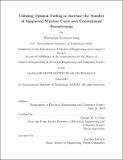| dc.contributor.advisor | Vincent W. S. Chan. | en_US |
| dc.contributor.author | Neeranartvong, Weerachai. | en_US |
| dc.contributor.other | Massachusetts Institute of Technology. Department of Electrical Engineering and Computer Science. | en_US |
| dc.date.accessioned | 2019-11-22T00:03:56Z | |
| dc.date.available | 2019-11-22T00:03:56Z | |
| dc.date.copyright | 2019 | en_US |
| dc.date.issued | 2019 | en_US |
| dc.identifier.uri | https://hdl.handle.net/1721.1/123042 | |
| dc.description | This electronic version was submitted by the student author. The certified thesis is available in the Institute Archives and Special Collections. | en_US |
| dc.description | Thesis: M. Eng., Massachusetts Institute of Technology, Department of Electrical Engineering and Computer Science, 2019 | en_US |
| dc.description | Cataloged from student-submitted PDF version of thesis. | en_US |
| dc.description | Includes bibliographical references (pages 101-102). | en_US |
| dc.description.abstract | The rapid growth of the number of devices and the gigantic amount of data present challenges to the healthy growth of telecommunication systems that is needed to support high-density environments. Multiple-antenna systems are deployed at base stations to support multiple users simultaneously on the same frequency, taking advantage of beamforming spatial diversity. In this thesis, we explore the application of antenna nulling in providing additional user coverage (as in increased number of supported users) over conventional beamforming. We consider, as a special case to validate the idea, the uplink line-of- sight narrowband transmission of a single base station equipped with uniform circular antenna array (UCA) through conventional, complete nulling, and optimal beamformers. We demonstrate, numerically and analytically, the average number of active users and outage probabilities under different beamformers, given a minimally acceptable signal-to-interference-and-noise (SINR) threshold and additional power margin. Variations of the antenna radius, number of antenna elements, and low- and high-SINR threshold are considered. We have shown a significant gain associated with the use of optimal beamformers instead of conventional beamformers. We discover that the improvements largely depend on the SINR threshold and is limited by the number of antenna elements for the unsaturated array and by the antenna aperture for the saturated array. | en_US |
| dc.description.statementofresponsibility | by Weerachai Neeranartvong. | en_US |
| dc.format.extent | 102 pages | en_US |
| dc.language.iso | eng | en_US |
| dc.publisher | Massachusetts Institute of Technology | en_US |
| dc.rights | MIT theses are protected by copyright. They may be viewed, downloaded, or printed from this source but further reproduction or distribution in any format is prohibited without written permission. | en_US |
| dc.rights.uri | http://dspace.mit.edu/handle/1721.1/7582 | en_US |
| dc.subject | Electrical Engineering and Computer Science. | en_US |
| dc.title | Utilizing optimal nulling to increase the number of supported wireless users over conventional beamforming | en_US |
| dc.type | Thesis | en_US |
| dc.description.degree | M. Eng. | en_US |
| dc.contributor.department | Massachusetts Institute of Technology. Department of Electrical Engineering and Computer Science | en_US |
| dc.identifier.oclc | 1127911255 | en_US |
| dc.description.collection | M.Eng. Massachusetts Institute of Technology, Department of Electrical Engineering and Computer Science | en_US |
| dspace.imported | 2019-11-22T00:03:55Z | en_US |
| mit.thesis.degree | Master | en_US |
| mit.thesis.department | EECS | en_US |
